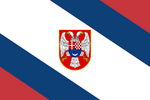Sebrenskiya: Difference between revisions
No edit summary |
No edit summary |
||
| Line 1: | Line 1: | ||
{{ | {{in use}} | ||
{{Infobox country | {{Infobox country | ||
Revision as of 23:25, 4 April 2019
This article is actively undergoing a major edit for a short while. To help avoid edit conflicts, please do not edit this page while this message is displayed. This page was last edited at 23:25, 4 April 2019 (UTC) (5 years ago). Please remove this template if this page hasn't been edited in several hours. If you are the editor who added this template, please be sure to remove it or replace it with {{Under construction}} between editing sessions. |
Republic of Sebrenskija Република Себренскија | |
|---|---|
|
Flag | |
| Anthem: Our Republic | |
| Capital and | Pančevo |
| Official languages | Sebrenskiyan |
| Recognised national languages | Maldanian |
| Recognised regional languages | Zetenskian Korensijan Resenian Vinican |
| Ethnic groups (2016) | Sebrenskan (41%) Maldanian (20%) Zetenskian (12%) Vinican (10%) Resenian (8%) Korensiyan (7%) Other (3%) |
| Religion | Sebrenskan Orthodox |
| Demonym(s) | Sebrenskan |
| Government | Unitary heredital-presidental parliamentary republic |
• National President | Dabiživ Sandić |
• Legislative President | Radomir Georgijević |
| Legislature | Republican Parliament |
| National House | |
| Federal Chamber | |
| Establishment | |
• Formation of the Kingdom of Sebrenskija | 903 |
• Republic Declared | January 17th, 1946 |
| Area | |
• | 380,647 km2 (146,969 sq mi) |
| Population | |
• Estimate | 57,055,201 (19th) |
• Density | 149.89/km2 (388.2/sq mi) |
| GDP (PPP) | estimate |
• Total | $2.205 Trillion |
• Per capita | $38,662 |
| GDP (nominal) | estimate |
• Total | $1.510 Trillion (19th) |
• Per capita | $26,481 (29th) |
| Currency | Sebrenskijan Dinar (SBD) |
| Time zone | UTC-9.5 (Sebrenskiyan Federal Time) |
| Driving side | right |
Sebrenskiya, officially the Republic of Sebrenskija, is a landlocked country situated in central Casaterra, on the crosssroads of Northern and Southern Casaterra. It is bordered by the Letnia, Eisenmatt and Vihoslavia to the north, Sieuxerr and Reberiya to the West, and Ostland to the south. The entire nation is contiguous, and is landlocked. Additionally, it is the furthest south majority slavic nation in Septentrion.
Sebrenskiya is considered to be the direct successor to the Kingdom of Pancevo, which was one of the first significant organized country by Slavic rule. For several years, several slavic kingdoms came to rise, before a sudden series of invasions in the early 13th century united them under the flag of Sebrenskiya. Maldania successfully ejected itself from the Sebrenskijan Empire in 1456, but peacefully rejoined it in the mid-19th century. Saintonge, which broke out after an invasion by the then-disposed Sieuxerran emperor, was reunited during the Pan-Septentrion War
Sebrenskiya is a member of the Letnian Commonwealth. It is an upper-middle income economy with a dominant service industry, which is followed by the industrial sector.
Etymology
It is uncertain where the phrase "Sebrenskan" came from to refer to the people of the area of Pancevo, but documents show the people being named that as far back as the 4th century. The Kingdom of Pancevo quickly expanded to take the vast majority of the area controlled by the Sebrenskan people, ejecting their minority-Eisen rulers. Sebrenskija, or The Land of the Sebrenskans, was adopted officially in 903, though evidence exists of the kingdom being referred to as that as far back as the 850s.
History
Pre-History
Ancient History
Rise of the Empire
Casterran Great-Power Competition
War of Senoran Succession
Pan-Septentrion War
Early Intervention
Against Saintonge
Against Ostland
Republic of Sebrenskija
1940s
1950s
1960s
Renewing tensions with Ostland
1970s
1980s
1990s
2000s
2010s
Geography
Climate
Environment
Politics
President
Republican Parliament
Law and Criminal Justice
Foreign Relations
Sebrenskiya has mostly positive relations worldwide, and is actively a part of the Letnian Commonwealth. Despite friendly relations with a vast majority of the world, Sebrenskiya is openly hostile towards its southern neighbor and is currently at war with Vyzhva.
Sebrenskiya also maintains a close relationship with Pireas.
Military
The Sebrenskan Armed Forces is operated under the Ministry of Defence, and is comprised of the Sebrenskan National Army, Sebrenskan National Air Guard, and Sebrenskan National Air Force. In 2018, Yugoslovneski defence spending was budgeted for $64.78 billion, or 4.29% of its GDP.
Mandatory conscription was abolished in 2018, and and now Sebrenskiya has 340,000 active frontline troops, 200,000 active reserve troops, and 215,000 passive reserve troops. Sebrenskiya has also been rapidly expanding its armed forces, in order to counter the growing threat from Ostland.
Sebrenskiya maintains mutual defence pacts with every state in the Letnian Commonwealth, Vihoslavia, and Pireas. Most of these states have a common enemy: Ostland, and thus have organized their militaries with reminders of the Pan-Septentrion War.
